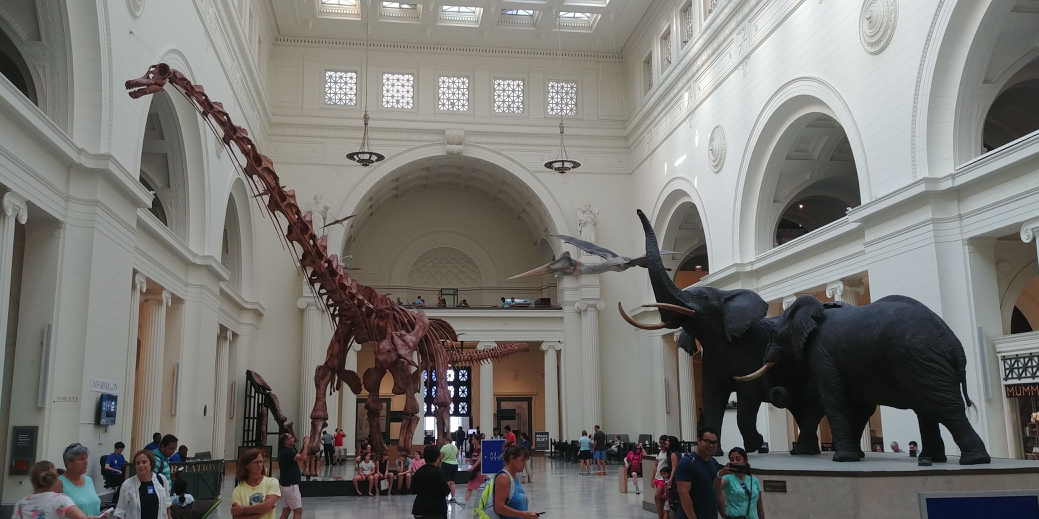
04 Aug Theming Prehistory: Immersive Exhibition and the Perils of Edutainment
The Field Museum of Natural History (Chicago, IL) | Akeley’s elephants are not impressed with such a static representation of prehistory; Máximo turns away in shame. Image provided by author.
August 4, 2020
By Nathan Cox
The 1914 release of Winsor McCay’s Gertie the Dinosaur is noteworthy for several reasons. In addition to being the first known moving image representation of a prehistoric animal, the film was also one of the earliest attempts to visualize an extinct creature for a mass audience. Presented as part of a vaudeville program, a live “trainer” (originally McCay himself) attempted to guide the unruly Gertie (a cartoon Brontosaurus) through a series of circus-like stunts before joining her on-screen as a live action image, whence the two would bow and depart together into the depths of the animated landscape.
As a multimedia presentation that seemingly transported a flesh-and-blood human into an animated reality, while continuing to address and interact with viewers, Gertie made prehistory accessible to the public in a way that was previously unknown. Earning widespread praise for the inventiveness of its concept, the quality of its execution, and the winning personality of its title character, the program was more than just accessible – it was truly engaging.
In spite of her status as an animated image, audiences were quick to comment on Gertie’s apparent authenticity. Due in large part to McCay’s talent for rendering natural movements, this spirited sauropod was by all accounts more realistic than the actual specimen, on display at the American Museum of Natural History and on which the cartoon was based.
As if these distinctions were not enough, one might go on to argue that Gertie was much more than a film, and even more than a fantastic show. The construction of a narrative universe that was entertaining and (above all) engaging, coupled with the opening of that universe to audiences, who were transported vicariously through a live performer, gives sufficient cause to classify it as a themed experience.
Theming is a practice by which most or all elements of the design and amenities at a commercial venue are employed in the service of a unifying idea, according to Scott A. Lukas in The Themed Space. This idea can be drawn from any source, such as a story, historical setting, or cultural identity. Whatever the context and purpose, a themed venue is one that is meant to be experienced beyond the bare mechanics of the products or services being offered.
Such is arguably the case with Gertie, modest as the show may seem in comparison to the latest attractions by the likes of Disney or Universal. We can point to earlier popular representations of extinct animals, such as London’s Crystal Palace Dinosaurs (1854), but the innovation of McCay’s film is the suggestion that prehistory is something to be immersed in, rather than merely looked at from afar.
Many experts in themed entertainment such as Lukas primarily study commercial sites such as amusement parks and other entertainment venues. However, these same researchers acknowledge that theming is employed in a variety of applications from education to transportation, such as the reconstructed Chauvet Cave paintings at Caverne du Pont-d’Arc, or Liverpool’s John Lennon Airport. Theming is a preferred practice for designers working in numerous cultural, industrial, and economic contexts.
This is especially clear if we consider two industries that in the last several decades have converged on this practice: amusement parks and museums. These share quite a bit of history: both have origins in the later part of the 19th century, both gained traction thanks to World’s Fairs, and both benefited from a rapidly expanding middle class, for whom spectacle and science coexisted with relative ease.
Add to this the fact that, due to ties to fossil fuel extraction, the field of Paleontology saw significant development and popularization during the same period, and it is no surprise that prehistory would come to demand as dynamic a presentation as exhibitors could envision. Always willing to collaborate, emerging media industries developed symbiotic relationships with scientific communities, ensuring that the public would never be in want of exciting visions of the prehistoric world.
Returning to our own time, we can see evidence of the continued intersection of parks and museums as both regularly employ theming techniques in their attractions. While the world’s two leading theme park brands (Disney and Universal) operate major dinosaur-focused attractions, natural history institutions such as Los Angeles’ George C. Page Museum and Chicago’s Field Museum of Natural History maintain high-profile immersive exhibits that engage similar subject matter.
Sharing methods, aesthetics, and practitioners, the edutainment sphere will continue to take shape as museums strive to be more entertaining and entertainment venues embrace educational content. Though opinions vary as to the implications of such a convergence, the suggestion that education can be a leisure pursuit is not new. While no definitive answers are to be found, these exhibitionary complexes are worthy of examination beyond the surface level.
Given that modern museum culture developed as a component of commerce-, industry-, and empire- building projects, scientific research and exhibition in the last 150 years have been influenced profoundly by culture, politics, and economics. As public institutions struggle to attract visitors and generate revenue it seems inevitable that many will explore strategies from, and collaborations with, the entertainment industries.
Although prehistoric life has been a part of human discourse at least as far back as Classical Antiquity, and one can reasonably argue that the practice of theming has a similar range, the two narratives did not begin to converge in earnest until quite recently. We have always found prehistory exciting, but as our knowledge grows more nuanced it seems that the distant past demands a mode of presentation to match.
If the exhibitionary industries are to be believed, themed attractions are positioned to do just that. As we have seen, however, such immersion should not be embraced without protest. One significant result of these developments in the edutainment sphere is the possibility that our conception of the natural world (both past and present), and our relationship to it, is or will be shaped in part by corporate interests. As impressive as these attractions can be, we would do well to look behind the curtain once in a while.
 Nathan Cox is a Ph.D. student in the Department of Film and Media Studies. His research explores popular representations of prehistoric life and evolution, with a focus on multimedia exhibitions and themed attractions.
Nathan Cox is a Ph.D. student in the Department of Film and Media Studies. His research explores popular representations of prehistoric life and evolution, with a focus on multimedia exhibitions and themed attractions.

